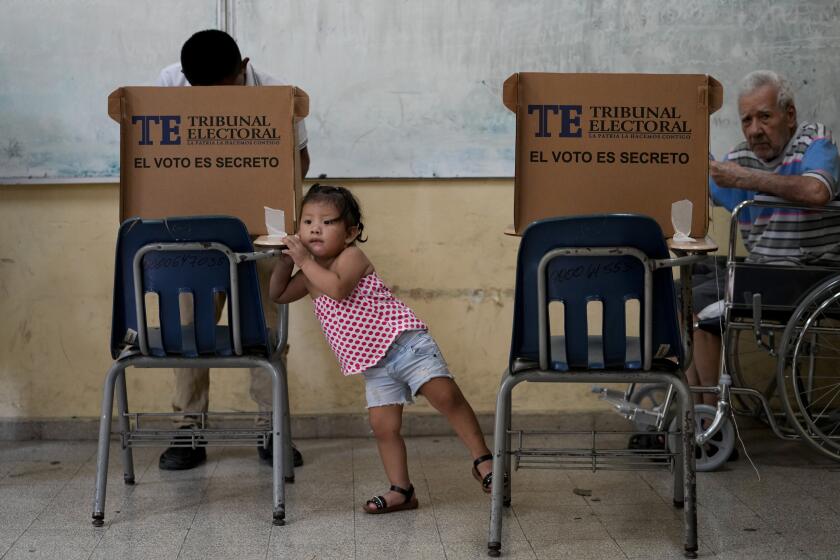For Thousands of Children, Aid Rides on a Definition
By this time next year, tens of thousands of disabled children may vanish from federal assistance rolls.
Their disorders will remain the same, their symptoms unchanged. What will be different is the way the government defines childhood disability.
The change is more than an exercise in semantics.
Social Security Administration officials say about 185,000 children in the United States may lose their monthly checks by next July because of a provision in the welfare reform law that seeks to limit federal assistance.
“We have to start reviewing their cases to see if they meet the new definition of disability,” said Tom Margenau, a spokesman for the Social Security Administration.
In California, 75,000 children receive such assistance, second only to New York. Of those, state officials say that more than 17,000 youngsters would be reevaluated and many of them could lose their benefits. Many have just won the right to the aid after a hard-fought court battle.
State and federal officials are not certain which children might be denied aid. The Social Security Administration has the job of converting a small section of the welfare reform law into comprehensive eligibility guidelines.
But the new law is expected to deal its toughest blows to children with behavioral problems and other mental impairments. Those children were accused in congressional hearings last year of faking disorders to qualify for Supplemental Security Income benefits--a charge later determined to be largely unfounded.
The changes also will effectively reverse part of a 1990 Supreme Court decision that opened the door for thousands of disabled children to receive monthly disability checks of about $400, as well as state Medicaid health benefits.
The law is not expected to eliminate children with severe physical disabilities.
But advocates nationwide have expressed concern that the Social Security Administration may be overzealous in its implementation in an effort to trim the budget.
“We are interested in seeing that the agency exercise its discretion in a way that harms the least number of children,” said Rhoda Schulzinger of the Bazelon Center for Mental Health Law in Washington, a nonprofit organization that represents the interests of low-income adults and children with mental disorders.
Schulzinger has joined other advocates and health care professionals in writing letters and attending meetings with Social Security officials, hoping to soften the potentially devastating financial blows.
Nationwide, about 1 million disabled children receive SSI. Low-income children are entitled to cash payments in addition to medical benefits. Medical benefits are provided to disabled children regardless of income. Of the 1 million children, nearly 300,000 are expected to be reevaluated under the new law.
For now, many families are not even aware of the changes. Notices will be sent beginning next month.
“We’ll have to send them a notice saying you need to come in and reestablish the cause of your disability,” said Edward Smallfield, a spokesman for the Social Security regional office in San Francisco.
This particular reform provision has drawn little attention so far, apparently overshadowed by the fate of welfare recipients and legal immigrants who also face new restrictions.
But for many families, SSI is a critical source of support.
Disabled children in California can each receive as much as $533.40 a month, along with Medi-Cal benefits. The amount varies depending on income. For example, a family of three with a monthly income of $2,600 can qualify for assistance. After turning 18, recipients must reapply for SSI benefits under guidelines for adults.
Under the new law, disabled children are eligible for cash and health coverage only if they have a “medically determinable impairment which results in marked and severe functional limitations” that are potentially fatal or last more than 12 months.
“The law is a short law,” said Barry Eigen, director of the medical and vocational policy branch of the federal office of disability, referring to the vagueness of the provision. The new law eliminates a test used in recent years to determine eligibility. The government has until Nov. 22 to issue its new eligibility guidelines.
Children who will be reevaluated are primarily those with certain types of mental disorders, and those who qualified for the program based on an eligibility test that came into use after a 1990 Supreme Court decision, Smallfield said.
That year the court determined that thousands of children had been illegally denied assistance because their disorder was not included on a list of eligible disabilities.
The government listing at the time did not include many common childhood conditions such as spina bifida, Down syndrome and autism.
As a result of the Supreme Court decision, children were generally allowed to qualify for assistance if they could not function at a level appropriate for their age.
The eligibility of children was determined from medical reports, as well as documentation from teachers, social workers and child care providers. Each application was reviewed by a disability examiner and by at least one physician working for the agency, said Dr. James Krajeski, a regional SSI medical advisor.
“The bottom line is, is the child or adult able to do either activities consistent with work, or activities consistent with a normal child--going to school and achieving at an appropriate grade level and social level?” Krajeski said.
The Supreme Court decision also required the agency to launch a national outreach campaign. That same year, SSI expanded its list of eligible disabilities to include maladaptive behavior, a category that includes children with personality disorders such as hyperactivity.
After the Supreme Court decision, advocates nationwide began notifying eligible families, some of whom had previously been denied aid.
“We were trying to let families know that the [rules] had been made more flexible and more all encompassing for children,” said Rachel Shigekane, managing attorney for the Volunteer Legal Services Program in San Francisco.
As a result, the number of children receiving SSI benefits has tripled from 300,000 to more than 900,000 over the past six years, according to a Government Accounting Office report. Benefit payments exceed $4 billion annually. The rate of new children qualifying on the basis of mental impairments tripled.
Many advocates say the decision to revise the eligibility requirements came in part because of the success of their outreach efforts, as well as the mood in Congress.
The growing number of children raised concerns among lawmakers, fueled by media reports, that some parents coached their children to behave as if they were mentally ill.
“Frankly, the SSI children’s program has grown out of control and well beyond helping truly needy children,” said Rep. Jim McCrery (R-La.) during congressional hearings on the program last year.
McCrery argued that some children were being placed on medication to treat mental disorders that simply do not exist, and others were not being treated for fear that SSI benefits would stop.
In September 1995, then-Sen. Bob Dole (R-Kan.) said that “children’s SSI needs a tuneup” and that he hoped that the changes in the law “will help restore confidence in this program.”
Jonathan Stein, a Philadelphia-based attorney who in 1990 argued successfully before the Supreme Court for expansion of federal disability benefits, said the proportion of children allowed into the program, compared with those applying, has already started declining.
Stein, a leading advocate for children’s assistance, said the move to restrict the program was based largely on anecdotal evidence of fraud--a belief echoed by many.
“It just never materialized,” Eigen said. “Obviously we found out things from time to time. In a program of this size, anything and everything can and does happen, but nobody has ever found any evidence of widespread fraud.”
Responding to congressional concerns, a national hotline was set up by the Social Security agency for teachers and other school personnel to report parents who they believed were coaching their children. Nationwide, about 230 children were reported from September 1994 through July 1995. Of those reports, only about half concerned children receiving benefits. The agency recommended further review in 83 cases.
In California, there were six calls.
In another study, federal officials reviewed 1,232 cases in which coaching was suspected. Only 77 of those children had been awarded benefits.
Children’s advocates argue that Congress ignored those and similar findings.
“I think these kids just got swept up in the whole rhetoric of welfare reform,” said Alice Bussiere of the National Center for Youth Law in San Francisco. “The other problem was there was a significant increase in the number of children. It looked like there was this big explosion of cases, but that was because the Supreme Court decision resulted in a liberalization of the rules.”
Supporters of the program acknowledge that implementation of the rules varied from state to state. And some said the program needed to assess disabled children periodically, to see if they still belonged in the program.
But the cure, they argue, is likely to do more harm than good.
“We think the president . . . and the Congress went overboard, way too far,” said Marty Ford, of the ARC, a Washington organization representing retarded citizens. “In terms of changing the eligibility criteria, their target went way beyond any of the problems that had been noted or substantiated.”
Now that the law has been passed, some worry that federal cost-cutting will come at the expense of innocent children.
“It’s part of the Social Security Administration saying we basically have a goal of eliminating people off of our rolls,” said Melinda Bird, managing attorney with Protection and Advocacy Inc., a disability rights law firm in Los Angeles.
“It’s more a cost goal than based on any evidence that these people aren’t disabled--that’s distressing.”
Social Security officials say that their goal is to implement the law and that they have not targeted a specific number of children.
Even without knowing yet what Social Security officials will do, advocates say they are preparing for the consequences of the agency’s decision--and trying to influence it.
A coalition of organizations has submitted recommendations for the new guidelines to the agency. And the Bar Assn. of San Francisco’s Volunteer Legal Services Program has started recruiting attorneys to assist families who may need representation in the reevaluation process.
At the same time, advocates do not want to cause unnecessary panic.
“One of our greatest fears is that people will say it’s not worth applying,” Schulzinger said. “We’re deeply worried that families will not be stepping forward for assistance to which they are legally entitled. This is not just a fictitious fear. Prior to the changes [in 1990], that’s exactly what happened.”
Times researcher Ron Weaver contributed to this story.
More to Read
Start your day right
Sign up for Essential California for news, features and recommendations from the L.A. Times and beyond in your inbox six days a week.
You may occasionally receive promotional content from the Los Angeles Times.






